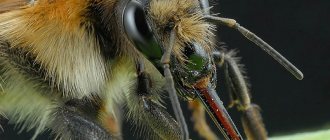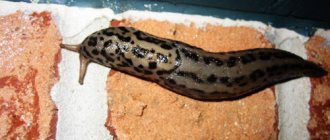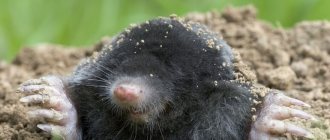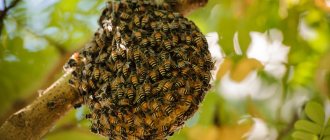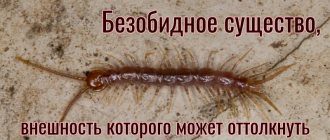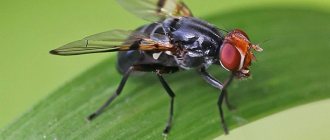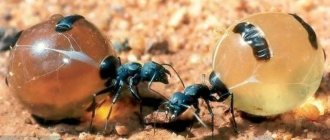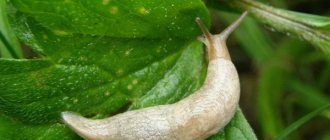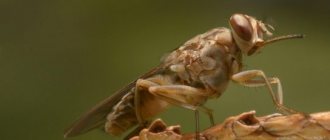- What do bumblebees eat?
The name of our today's hero - the bumblebee - came about thanks to the sounds that it usually makes during the flight, such buzzing, wheezing, from them came the ancient Russian word “chmel”, which over time transformed into the familiar modern “bumblebee”. By the way, the name of another well-known flyer was formed in a similar way -
mosquito But back to bumblebees, scientifically speaking, a bumblebee is an arthropod insect and belongs to the subclass of winged insects, the family of true bees, the genus of bumblebees proper (Bombus in Latin).
Description, structure, characteristics
Bumblebees are very large and bright insects, and interestingly, the female bumblebee is larger than the male (which, however, is not such a rarity in the world of insects). Typically, the body length of a female bumblebee is from 13 to 28 mm, a male - from 7 to 24 mm. But some types of bumblebees, such as the steppe bumblebee, can reach large sizes, even up to 35 mm in length. The weight of a bumblebee, if it is a queen, can reach up to 0.85 g, but working individuals will be lighter - from 0.04 to 0.6 g.
An interesting fact - despite their absolute small weight, bumblebees are quite strong insects and can carry a load equal to their own weight.
The body of a bumblebee is thick and heavy, as for an insect, of course. The wings of a bumblebee are small, transparent and consist of two halves that move synchronously. The flapping speed of a bumblebee's wing is 400 beats per second. And the flight speed of a bumblebee can reach 3-4 meters per second.
The female bumblebee's head is somewhat elongated, while the male's is triangular in shape, with a noticeable dotted line on the crown and front part.
Bumblebees also have powerful mandibles, which they use to chew through plant fibers and to create honeycombs. They also serve the bumblebee for protection.
The eyes of a bumblebee are located in a straight line, they are not covered with villi. The antennae of males are longer than those of females.
An important organ of bumblebees is a special proboscis, which they use to collect nectar. The length of the proboscis depends on the type of bumblebee and varies from 7 to 19 mm.
There is also a sting in the abdomen of bumblebees, but only in females; the male does not have a sting, and in place of the sting there are dark brown genitals. The sting of a bumblebee is smooth, without serrations and invisible when at rest. So when bitten, the female bumblebee pulls the sting back and can sting repeatedly like wasps and
hornets, unlike bees, which die after being stung.
Bumblebees also have as many as six legs, while the female has a special “basket” for collecting pollen on the outer surface of her hind legs.
The color of the bumblebee is usually striped, black and yellow with white, orange and even red flowers. Sometimes there are completely black bumblebees. Scientists believe that the color of the bumblebee was created for a reason, but is associated with the balance and thermoregulation of the insect’s body.
Bumblebee appearance
Usually the insect has a black and yellow striped color, but depending on its habitat, individuals with completely black hair or with red stripes are observed. The color is also justified by the need for camouflage. Females can reach up to 3.5 cm in length, while males do not grow longer than 2.5 cm. Bumblebees have the fastest vision in the animal world - they have one pair of eyes in the front and photocells on the back of their heads, which help in determining the time of day. In addition to visual organs, they have strong jaws and a special proboscis for collecting nectar.
The photo shows a close-up of a bumblebee.
The appearance of female and male individuals differs in several ways. The head of female bumblebees has an elongated shape with a wide curve at the back. The upper lip is rectangular in shape and contains largely curved mandibles that close when compressed. In female organisms, the sixth abdominal sternite is always without characteristic ridges, and on the abdomen itself there is a multiple-acting sting without serrations. A basket is formed on the hind legs for collecting and storing pollen.
Male bumblebees have a triangular head, close to round, with a thin broken line running along the front and crown. Males on the second sternum do not have a median eminence, and instead of a sting, the genitals are dark brown. In addition, males have powerful jaws that allow them to chew through grass stems. They do not have a pollen basket, but instead have more pubescence.
Habitats
Bumblebees live almost everywhere, on all continents, with the exception of the cold
Antarctica. They are especially common in temperate latitudes, but there are certain species of bumblebees that live even beyond the Arctic Circle, in the tundra. Bumblebees are a frequent visitor in mountainous regions, but closer to the equator, in the tropics, there are not so many bumblebees; for example, only two species of bumblebees live in the Amazon forests. Also, at the beginning of the twentieth century, some species of garden bumblebees from Europe were brought to Australia and New Zealand, where they live to this day.
In general, bumblebees are the most cold-resistant members of the bee family. Despite the fact that they do not like the hot tropics very much, all this is due to the peculiarity of their thermoregulation, the fact is that the normal body temperature of a bumblebee can reach 40 degrees Celsius, exceeding the ambient temperature by 20-30 degrees. This increase in temperature is associated with the rapid contraction of the bumblebee's chest muscles, the same contraction that is the source of its signature buzzing.
Do bumblebees make honey?
Like other representatives of the bee family, bumblebees also produce honey, only the product of their activity has slightly different properties. It has a thinner consistency, similar to sugar syrup, and is much lighter than bee honey. It also has a lower specific gravity and is not as sugary as that of bees, but such honey is 2 times healthier than bee honey.
Bumblebees create honeycombs in the unusual shape of pitchers. Their number is smaller than that of bees, but they are more spacious. Toward the bottom, the honeycomb expands slightly in diameter, and when sealed, it becomes bag-like.
Bumblebees live no more than a year, so breeding them for the sake of a small amount of honey is pointless and unprofitable.
Nest
Bumblebee nests can be underground, on the ground, or above the ground; let’s look at them in more detail.
Nests underground
Many species of bumblebees build their nests underground, sometimes even nesting in the burrows of various rodents. Interestingly, the smell of mice attracts female bumblebees. Also in the mouse hole there is a lot of useful material for insulating a bumblebee nest: wool, dry grass, etc.
Nests on the ground
Some types of bumblebees, for example, Schrenk's bumblebee, forest and field bumblebees, build their nests on the ground: in the grass, under plants, even in abandoned bird nests.
Nests above ground
Some types of bumblebees prefer to make their nests above the ground: in tree hollows and birdhouses.
The shape of underground and above-ground nests can be different and depends on the cavity used by bumblebees. The nests are insulated with dry grass, moss, and reinforced with wax secreted by bumblebees using special abdominal glands. From this wax, bumblebees build a wax dome that prevents the penetration of moisture; it also masks the entrance to the nest to protect against the invasion of uninvited guests.
Where and how do bumblebees winter?
The bumblebee community exists from early spring to early winter. At the end of autumn, the males fertilize the main females for the last time, after which the queens hibernate and all other residents of the hive die. The queen survives frost underground at a depth of approximately 15-20 cm, usually in a place not far from the old nest. When spring comes, the main females awaken from sleep, create a new home, where they raise the first generation of new offspring and then die. They are replaced by newly hatched females.
Lifestyle in nature
Bumblebees, like other insects of the bee family, are social creatures and live in families consisting of:
The queen is responsible for reproduction, although in her absence, female workers can also lay eggs. The bumblebee family is not as large as the bee family, but still numbers 100-200, and sometimes as many as 500 individuals. The life cycle of a bumblebee family usually lasts from spring to autumn, after which the family breaks up, some of the females go to winter to begin a new life cycle in the spring.
In the bumblebee family, each has its own specific responsibilities: working bumblebees get food, feed the larvae, arrange and protect the nest. At the same time, among working bumblebees there is also a division of labor, so larger representatives fly for food, and smaller ones feed the larvae.
The function of males is simple and clear - fertilization of females. The queen of the bumblebee, she is also the female founder of the family, lays eggs, feeds the larvae, and generally takes care of the offspring.
Bumblebee lifestyle and habitat
Due to their rapid adaptation to environmental conditions, bumblebees are found in every part of the world except deserted Australia and deserted Antarctica. Most often they are found in Europe and Africa. Depending on their habitat, their appearance and habits vary slightly.
Bumblebees live in families of about 100-200 individuals, less often - 500, consisting of queens, workers and males. In any community there is a clear division of responsibilities - queens are engaged in breeding offspring, workers build housing, bring food, feed larvae and collect nectar, and males only fertilize females. The first larvae emerging from the eggs are fed personally by the queen; subsequent generations are already under the care of the workers. If the queen dies, a working female takes her place. After fertilization, males leave the community forever. The family lives for one season, with the exception of the queens - they survive the winter.
An interesting fact is that the community has a unique trumpeter bumblebee, which can be heard in the mornings. It signals low air temperature and, with its loud sounds, awakens the entire hive so that its fellow tribesmen can quickly warm up the hive.
Bumblebees are beneficial insects that pollinate plants, including those that are inaccessible to bees. Therefore, they are not interested in anything other than flowers, and if disturbed, they will simply fly away to another plant.
Reproduction
Bumblebee reproduction has four stages:
- Egg.
- Larva.
- Doll.
- Imago (aka adult).
With the beginning of spring, the queen, which has overwintered and is fertilized in the fall, flies out of her shelter and within several weeks is actively preparing for nesting. Having found a suitable place for the nest, the queen begins construction. In a newly built nest, the queen lays 8-16 eggs, which have an elongated shape.
After 3-6 days, bumblebee larvae appear, they grow quickly, feeding on food brought by the female.
After 10-19 days, bumblebee larvae begin to weave a cocoon and pupate. After another 10-18 days, young bumblebees begin to emerge from the cocoons, gnawing at them. By the way, later empty cocoons can be used to store honey or pollen. After the appearance of the first offspring, 20-30 days after the eggs were laid, the queen almost never leaves the nest. The responsibilities for obtaining food are taken over by its first children - working individuals who also perform all other important functions.
As for born males, 3-5 days after formation into an adult, they leave their parental nests in search of other nests and other queens, with whom they will mate in the fall, during the mating season of bumblebees.
What do bumblebees eat?
Bumblebees feed on absolutely any nectar; some species especially love clover nectar. Insects also eat tree sap. The process of collecting food and eating it lasts from morning to evening. Relatives of bees prefer to process bright flowers, although this is not justified. In addition, they disperse seeds as they feed.
Larvae also need food, so upon returning to the nest, workers try to bring as much pollen and nectar as possible, which serve as food for future offspring. If necessary, the larvae are also fed with self-made honey.
Types, photos and names
In nature, there are about 300 varieties of bumblebees; of course, we will not describe them all, but we will describe the most interesting representatives of the bumblebee world, in our opinion.
meadow bumblebee
It is also known as Bombus pratorum in Latin and lives almost throughout Europe, as well as in Asia (Kazakhstan, the Asian part of the Russian Federation, the taiga, the Urals, and Siberia). It is small in size: females reach 15-17 mm in length, working individuals 9-14 mm. The head is dark, and behind it is a bright yellow collar. They are interesting because it is the bumblebees of this species that are the first to fly out of wintering in the spring. They nest on the surface of the ground or in bushes.
urban bumblebee
This bumblebee lives throughout Eurasia, from Ireland in the West to Sakhalin in the East. A very small representative, the female’s body length is 10-22 mm, workers’ body length is 9-15 mm. It is distinguished by a red breast, and on the abdomen it has a black band and a white tip.
Steppe bumblebee
It is a very large representative of the bumblebee family, the body length of females reaches 32-35 mm. Has almost square cheeks. The color of the steppe bumblebee is paleish-grayish-yellow with a black band between the wings. This bumblebee lives in Eastern Europe, including Ukraine, Asia Minor, Northern Iran, and Transcaucasia. The steppe bumblebee prefers flat, foothill and mountain steppes. It makes nests in rodent burrows in the ground. Listed in
Red Book of Ukraine.
Bumblebee underground
This bumblebee is distinguished by its elongated proboscis, as well as its elongated body and love of warmth. Distributed in Eurasia, from Great Britain to the Urals. The yellow color of this bumblebee is duller than that of other bumblebee species. It has average sizes: females reach 19-22 mm, working individuals 11-18 mm. Interestingly, the underground bumblebee was one of four species of bumblebees brought from England to New Zealand for the purpose of pollinating the local clover. As its name suggests, it makes nests underground.
Moss bumblebee
Lives over a wide range: Eurasia, almost everywhere except the polar regions. Dimensions reach 18-22 mm, working individuals 10-15 mm. It has a bright yellow-golden color and an orange back. Builds ground-type nests.
Earth bumblebee
This bumblebee is distinguished by a back with a reddish-black band and a black upper chest. Females reach 19-23 mm in length, working individuals 11-17 mm. They live in Europe, western Asia and northwestern Africa. Interestingly, at the end of the twentieth century, a method for industrial breeding of this type of bumblebee was developed. The fact is that the ground bumblebee brings considerable benefits, helping to pollinate various crops (including tomatoes, eggplants, cucumbers, peppers and strawberries).
Armenian bumblebee
A rare representative of the bumblebee kingdom, in many countries, including in Ukraine, it is listed in the Red Book. Lives in Eastern Europe and Asia Minor. The body length of this bumblebee is 21-32 mm. It has brown wings and elongated cheeks.
forest bumblebee
A small representative of the bumblebee kingdom, with a slightly duller coloration than other bumblebees. Loves warmth, lives in dry meadows of forest-steppes. It builds nests on the surface of the earth from grass and moss, however, sometimes using warmed ones as nests.
sun holes of rodents.
garden bumblebee
Just like the underground bumblebee, it was once brought by the British to New Zealand, where it lives to this day. And besides this, you can meet the garden bumblebee across a wide range from England to Siberia. The uterus is 18-24 mm in length, workers are 11-16 mm. The breast of this bumblebee is yellow with a black stripe between the wings. It also has a very long proboscis and nests underground, in old holes left by rodents.
Common bumblebee
It lives in western Europe and is listed in the Red Book. It is black in color with two yellow stripes.
Features of bumblebees and differences from bees and wasps
Based on certain characteristics, you can easily distinguish bumblebees from their closest relatives - bees and wasps.
Bumblebees are noticeably larger than bees and wasps; in particular, this effect is achieved due to a thick layer of villi. Also, the coloring of wasps and bumblebees is brighter and more intense compared to bees.
The main difference between bumblebees and wasps is that they are vegetarians and feed exclusively on pollen and nectar. Wasps eat everything, not disdaining to eat other insects. In addition, they make preparations for the winter and leave with the whole family for the winter itself.
Wasp, bumblebee and bee.
Wasps and bumblebees can easily remove their stings from the victim and reuse them - they are smooth, without jagged edges. Moreover, wasps are very easy to anger, but bumblebees are not interested in this, and they sting very rarely. Bees leave their sting in the victim, as it is barbed and has a lock on the end, and die immediately, so they only use the sting when defending the hive.
All of the insects described above can produce honey, but only bee honey is widely consumed, while the rest are of little value to people or are too difficult to scale up production.
What to do at home if bitten by a bumblebee
Of course, it is best to simply prevent a bumblebee from being bitten; to do this, you just need to not try to pick up a bumblebee, but in nature, make sure that you don’t accidentally land on a bumblebee with your “soft spot.” But if a bumblebee bite does occur, then first aid should be as follows:
- The bitten area must be disinfected with an antiseptic,
alcohol or soap and water.
Natural enemies of bumblebees
Bumblebees have many natural enemies, despite their neutrality and usefulness. Ants are one of the main serious enemies of the bee family. They steal their eggs and honey and destroy their hives, so bumblebees often build their homes away from the ground. Communities try to defend their homes, but the defense is often ineffective as most fly away during the day to pollinate flowers and collect nectar.
Another unpleasant enemies are birds, animals and other insects. For example, predators like foxes, hedgehogs and wolves destroy nests and eat offspring. Conopid flies lay their eggs in the bodies of bumblebees while they fly. They grow by feeding on the innards of their prey.
Bumblebees even conflict with representatives of a related species - wasps, since the latter often steal honey, eat larvae and lay their own on enemies.
Interesting Facts
- Bumblebee farming is an important branch of agriculture; bumblebee breeding is actively practiced to increase crop yields.
- Previously, it was believed that, according to the laws of aerodynamics, a bumblebee was simply not capable of flying and its flights, seemingly contrary to the laws of physics, surprised scientists. However, one Zheng Jane Wang, a physicist from Cornell University in the USA, was able to explain the mechanism of bumblebee flight to the principles of aerodynamics.
- In the morning hours, a curious character appears in the bumblebee nest, the so-called trumpeter bumblebee, buzzing loudly. Previously it was believed that in this way he raises his relatives to work. But later it turned out that in such a simple way (with the help of the work of the pectoral muscles) this bumblebee simply warms up in the predawn, the coldest hours.
Why do some gardeners breed bumblebees?
Breeding bumblebees is a godsend for gardeners; it is used to improve the yield of agricultural crops, as well as to increase their number. Honey is just a pleasant bonus from bumblebee farming, since little of it is produced, and bumblebees can suddenly leave their home.
Bumblebees bring many benefits, so many summer residents decide to breed them at home. Usually about 50 individuals from one family are placed in a pre-prepared nest. This will allow them to get along well with each other, distribute responsibilities correctly and begin pollinating plants.
If colonization is successful, the queen quickly begins to produce new offspring, and workers begin to set up the farm. Before the onset of cold weather, the owner must fatten the queen so that she can survive the winter.
Video
And in conclusion, an informative video about bumblebees.
Author: Pavel Chaika, editor-in-chief of Poznavaika magazine
When writing the article, I tried to make it as interesting, useful and high-quality as possible. I would be grateful for any feedback and constructive criticism in the form of comments on the article. You can also write your wish/question/suggestion to my email [email protected] or Facebook, with respect, the author.
Author page
Bumblebee protection
There are several hundred species of bumblebees in the world, many of which are on the verge of extinction and are listed in the Red Book. There are several good reasons for reducing their numbers: air pollution, insufficient food, the use of pesticides, hostility with serious rivals. Some species of the family are attached to certain types of plants, and with their disappearance they themselves are endangered.
Modern man makes no effort to protect these helpers. The indifference is due to the fact that simultaneously with the gradual extinction of several species of bumblebees, there is an increase in the population of others, and in general the community remains unchanged in its numbers.
Wintering of insects
When studying the life features of these insects, you need to know how the bumblebee winters in order to clearly understand its life cycle. The bumblebee family lives only during the summer; only the young queens remain for the winter. But after hibernation it is difficult to see them, since they have been building their new nest since early spring. In arranging a new home, all available materials are used: moss, dry grass, fluff. It is still cold outside, so the female needs to actively flap her wings to maintain her body temperature. The nests must be completely ready before the eggs are laid.
New individuals emerge from the laid eggs and collect nectar, pollen and expand nests. In the fall, the entire family dies, except for the young fertilized queens, which will spend the winter, and in the new spring they will begin the life cycle of bumblebees in a new circle.
Only young queens remain for the winter
The answer to the question of where bumblebee queens spend the winter is ambiguous. Insects look for secluded places: cracks in trees, burrows, hollows, cracks in the walls of houses and other buildings. If a suitable reliable place is not found, the female can dig a hole in the soil on her own. When it gets cold, the insect falls into a state of torpor and remains there until the weather warms up in the spring. The state of sleep or torpor is a state similar to how bumblebees hibernate in nature.
On a note. Not all fertilized females survive winter. As numerous studies have shown, only a third of the representatives who fall asleep wake up in winter and begin building new homes.
Lifestyle, behavior
I wonder where bumblebees live? Bumblebees, like other insects, are active almost all summer, but this period is different for all species. This depends on their habitat (high or low latitudes).
Those species that live far in the north, with a short one-month summer, do not have time to create a family and live as solitary insects.
In temperate climates, an established family lives for one summer. In tropical zones, some species organize perennial families.
Where do bumblebees live in winter? During this period they live in underground shelters.
How and where do bumblebees nest and live? These insects have an amazing rare feature. Unlike other similar insects, all bumblebee larvae develop and are reared in one common chamber. In the free cells, the female creates reserves of honey and bee bread (honey dough) for periods of bad weather.
general information
A bumblebee is practically the same bee, but it is not cultivated in agriculture. The main habitat is wild nature (meadows, fields, forests, mountains), where there is a cluster of flowering herbs.
The bumblebee is a social insect and is subordinate to the life of the genus, which has its own hierarchy: the uterus, working females and fertilizing males. Among working individuals there is also a division. Some build nests, others protect them. There are females who are responsible for collecting food and those who feed the larvae.
Bumblebee
The bumblebee family is not as numerous as the bee family, but one nest can accommodate from 100 to 500 individuals. Despite the large number of working females, they do not know how to settle down - their houses do not look as neat as those of their bee relatives.
Additional Information. For shelter, insects often choose tree hollows, cracks in old stumps, and mountain crevices. You can also find bumblebee houses in bird nests. Often insects “expropriate” them from their owners by force, leaving a whole swarm of birds surviving.
The honey produced by furry arthropods is unsuitable for food - it has an unpleasant taste. And not much of this product is produced, exclusively for our own consumption. Therefore, ordinary people sometimes have questions about the advisability of the existence of these insects.
To understand how useful bee relatives are, you need to find out what a bumblebee does in nature. Scientists have already proven that these insects are the best pollinators of plants, compared to the inhabitants of apiaries. Knowing this feature, farmers try to attract bumblebees to their lands. In addition, the presence of insects in the region is a sign of good environmental friendliness.
Which bumblebees do not build nests and do not collect nectar?
Not all bumblebees have exemplary families, the representatives of which perform the functions assigned to them. There are so-called cuckoo bumblebees (also known as parasitic bumblebees or whisperers) (lat. Psithyrus), which belong to the subgenus of social parasites from the genus of bumblebees and include 29 species. These lazy people do not build their own nests and do not collect nectar. Each of the parasitic species, as a rule, looks very similar to its host. Female cuckoo bumblebees can sometimes be distinguished only by the absence of pollen-collecting devices (brushes and baskets) on their legs. A female cuckoo enters a bumblebee's nest and lays eggs. Worker bumblebees feed the larvae as if they were their own. Therefore, cuckoo bumblebees do not need workers. Some species of cuckoo bumblebees, such as Bombus Rupestris, Bombus campestris, Bombus barbutellus, Bombus quadricolor, parasitize several species of bumblebees. Some species of parasitic bumblebees have only one host: for example, Bombus bohemicus chooses the burrow bumblebee (lat. Bombus lucorum) as its host. Having penetrated the host's nest, cuckoo bumblebees behave differently: some species are aggressive, they kill the queen and guards, others coexist for some time.
Photo credit: Alvesgaspar, CC BY-SA 3.0
Features of social life
Like bees, bumblebees are social insects. They organize huge families numbering up to 200 individuals.
In such communities where bumblebees live, there is a surprisingly clear distribution of responsibilities for absolutely each of its members.
Many species have so-called small queens (this is the average between queens and workers). The latter, together with workers and small queens, build nests, collect honey and pollen (food) and lay unfertilized eggs, from which only males develop. And from the very last eggs laid by the queen, new queens hatch, which, in turn, are fertilized by males.
Only old queens remain for the winter, since the old ones die, males, workers and small queens also die. The entire community disperses.
Bites and consequences
This insect is considered peaceful. It is not aggressive and bites only in defense, for example, when closing the entrance to a nest. But such a bumblebee bite is weak and not harmful. Females sting when threatened. The sting does not remain in the body, compared to a bee, so bumblebees do not die after being stung. But the poison causes pain, itching, and redness. There may be swelling. Symptoms may persist for several days.
Insect venom is similar to bee venom, but contains fewer components that can cause a toxic reaction. For most healthy people this is not dangerous. It is better to prevent a bumblebee bite, but if this happens, first aid should be provided:
- Treat the painful area with an antiseptic, alcohol or soap and water.
- Apply a cold compress.
- Provide plenty of warm fluids.
- Eliminate itching with an antihistamine, for example, Suprastin.
You can remove the consequences of a bite at home using folk remedies. Compresses made from gruel with soda, an aspirin or validol tablet diluted in water will help. Infusions of tansy or chamomile are suitable. Crushed leaves of parsley, plantain, and dandelion have a healing effect. Compresses need to be changed after 2 hours. Shredded potatoes, onions, and apples give an excellent effect. If you are severely bitten on the neck, eyes, or lips with the appearance of an allergy, you should consult a doctor.
Bumblebees are considered important pollinators of meadow, forest, and agricultural crops. Many insect species perform cross-pollination several times faster than bees. They pollinate clover, alfalfa, and legumes.
Ants are harmful to bumblebees. They can steal honey, eggs, and larvae. Therefore, insects prefer to build nests above the ground, far from anthills, as well as underground. Wasps and brachycoma flies can steal honey. Conopid flies are dangerous for them. Bumblebee offspring can be destroyed by the caterpillars of the moth moth.
Thus, bumblebees are unique insects that are beneficial to nature. And they can cause harm only for the purpose of self-defense.
Lifespan
Wasp, bee, bumblebee, hornet - differences
Having found out how bumblebees reproduce, we should address the question of how long they live. In the spring brood, a new queen may be born, whose age ends in the spring, with the last clutch. The “queen” born in autumn sometimes has a life expectancy of up to a year.
All other individuals in the swarm have short eyelids. Males, having reached sexual maturity, complete their mission of fertilization within a month and die a few days after mating. Working females die even earlier - 2 weeks after turning into adults, until they are replaced by the next generation.
Color “varieties”
The easiest way, according to experts, is to distinguish hairy insects by the color of the bristles, as well as the color of the characteristic features of the body structure. Below we will talk about what honey collectors are like from this point of view.
- Painted in alternating yellow, black and white colors:
- garden;
- small earthen;
- underground.
- With a visible dark stripe on the back, a burgundy end of the abdomen and a basic gray-yellow tint:
- steppe;
- forest.
- Bright yellow, with a spot or dark stripe between the wings:
- carder;
- spotted back.
- Gray with a visible black stripe on the back:
- field;
- urban.
- Pure black interspersed with red - at the end of the abdomen:
- stone;
- small stone;
- horse.
- Yellow-red:
- volatile;
- moss.
Individuals of an insect pest called the cuckoo bumblebee can masquerade as the females of all the bumblebees listed above.
Literature[edit | edit code]
- Bumblebees // Encyclopedic Dictionary of Brockhaus and Efron: in 86 volumes (82 volumes and 4 additional). - St. Petersburg, 1890-1907.
- Key to insects of the Russian Far East. T. IV. Reticuloptera, Scorpioptera, Hymenoptera. Part 1 / under general ed. P. A. Lera. - St. Petersburg: Nauka, 1995. - P. 552-553. — 606 p. — 3150 copies. — ISBN 5-02-025944-6.
- Charles Duncan Michener (2000). The Bees of the World
. Johns Hopkins University Press. - “Bees.” World Book Encyclopedia 1998 ed.
- Hasley, William D. “Bees.” Collier's Encyclopedia 1990 ed.
- Freeman, Scott. Biological Science. New Jersey: Upper Saddle River, 2002.
- Abbott, Carl, and Bartlett, John. "Bumble Bees" Encarta Encyclopedia. 2004 ed.
- Goulson, Dave. “Bumblebees: Their Behavior and Ecology” 2003. Oxford University Press ISBN 0-19-852607-5
- Macdonald, M. & Nisbet, G. 2006. “Highland Bumblebees: Distribution, Ecology and Conservation.” HBRG, Inverness, hbrg.org.uk. ISBN 0-9552211-0-2.
- Schweitzer, Dale F. et al. (2012). Conservation and Management of North American Bumble Bees
. Washington DC: US Forest Service.
Features of bumblebee nests in the ground
After wintering, the fertilized queen begins to engage in construction. Most often, she places a bumblebee hive in the grass or between stones. Often, holes and burrows dug by small rodents are selected.
The first dwelling, which was built by the queen or the founder of the family, is an irregularly shaped oval cell. They are made from brown or red wax. The female lays 6 eggs at the bottom of each wax cell; a little honey and pollen are also placed in them to feed the emerging larvae. Only the first cells in bumblebee nests are made of wax; subsequently, the empty cocoons of pupae that have already hatched are used for such purposes. All created cells that do not contain larvae are filled with coarse honey and pollen. Some of the cells with honey and pollen remain untouched for a long time; they are intended for bad weather, when insects cannot fly out for food.
As the larvae grow, the cell walls move apart. To prevent the home from falling apart, the queen is constantly repairing the walls. As the colony expands, worker bees will help with repairs. When the time comes, the larvae pupate and inside the cocoon they turn into adults. After the completion of the formation of a new insect, the queen gnaws through the walls of the cocoon so that the young generation appears. The first bumblebees after laying eggs appear on days 25-27.
After wintering, the fertilized queen begins to engage in construction.
Lifespan
Another question that many who study buzzing insects are interested in is how long a bumblebee lives. The lifespan of one bumblebee is very short. On average it does not exceed 2 weeks.
Insects die for completely different reasons, but most often they simply wear themselves out, trying to collect as much nectar as possible. The lifespan of males does not exceed a month; they die soon after mating. Young fertilized females manage to live the longest, but they spend most of their time sleeping in winter. After mating, future queens go to winter, and the males die. Then they create a new nest, lay eggs, feed the larvae and die.
